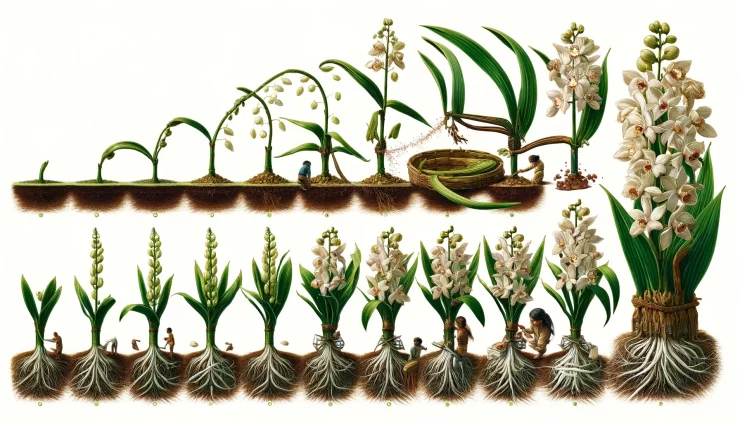Vanilla, often considered the crown jewel of flavors in the culinary world, derives its unique aroma and taste from the slender, aromatic beans of the vanilla orchid. While it’s widely used in baking, cooking, and perfumery, growing vanilla beans isn’t as simple as planting a seed and waiting for it to sprout. It requires patience, attention to detail, and specific growing conditions. In this guide, we’ll walk you through the process of cultivating vanilla beans from planting to harvest.

Understanding Vanilla Orchids
Vanilla orchids belong to the genus Vanilla, primarily Vanilla planifolia, which is the most commonly cultivated species for vanilla bean production. These orchids are native to Mexico and require specific conditions to thrive. In the wild, vanilla orchids are epiphytic, meaning they grow on trees, but they can also be grown in soil.
Planting Vanilla Orchids
Choose the Right Location: Vanilla orchids require a warm, humid climate with filtered sunlight. They thrive in tropical or subtropical regions. If you’re growing them indoors, ensure they receive bright, indirect light.
Prepare the Soil: If planting in the ground, ensure the soil is well-draining and rich in organic matter. A mixture of peat moss, perlite, and compost works well. For container planting, use a potting mix designed for orchids.
Planting Process: If planting in soil, dig a hole slightly larger than the orchid’s root ball. Gently place the orchid in the hole and backfill with soil. If growing in a container, ensure there are drainage holes and plant the orchid at the same depth it was in its original container.
Caring for Vanilla Orchids
Watering: Keep the soil consistently moist but not waterlogged. Allow the top inch of soil to dry out between waterings. Mist the leaves regularly to maintain humidity, especially if growing indoors.
Fertilizing: Use a balanced orchid fertilizer during the growing season (spring and summer) and reduce fertilization during the dormant season (fall and winter).
Support and Training: Vanilla orchids are climbers and require support as they grow. Provide a trellis or stake for the vines to cling to. Train the vines to grow upward to maximize air circulation and prevent disease.
Pollination: Vanilla orchids are typically pollinated by specific bees and hummingbirds in their native habitat. However, in cultivation, pollination is often done manually. This process requires delicate hand-pollination to ensure successful fruit set.
Harvesting Vanilla Beans
Patience is Key: Vanilla orchids typically take several years to mature and produce beans. Once the plant reaches maturity, it may produce flowers, which eventually develop into vanilla beans.
Monitoring Maturity: Vanilla beans are ready for harvest when they reach their full size and begin to turn yellow. The beans should be plump and exude a rich aroma.

Harvesting Process: Carefully handpick the mature beans from the vine using small scissors or pruning shears. Be gentle to avoid damaging the plant.
Curing and Drying: After harvesting, the beans undergo a curing process to develop their characteristic flavor and aroma. This typically involves blanching, sweating, drying, and conditioning the beans over several weeks.
Storing Vanilla Beans: Once cured, store the vanilla beans in airtight containers away from light and heat. Properly stored vanilla beans can last for several years.
Growing vanilla beans can be a rewarding endeavor for both hobbyists and commercial growers alike. By providing the right growing conditions and care, you can enjoy the satisfaction of harvesting your own flavorful vanilla beans to elevate your culinary creations. With patience and dedication, you’ll soon be indulging in the exquisite taste of homegrown vanilla.
News
JJ Redick reacts to Luka Doncic trade for Anthony Davis
In one of the most jaw-dropping moves of the season, the NBA landscape was rocked by the blockbuster trade involving Luka Dončić and Anthony Davis—a swap that has sent ripples of excitement, disbelief, and heated discussion through the league. Among…
Anthony Davis FULL reaction to trade to Mavericks for Luka Doncic
In a blockbuster move that sent shockwaves through the NBA and left fans reeling, Anthony Davis has been traded to the Dallas Mavericks in exchange for Luka Dončić. In the immediate aftermath of the news, Davis took to the media…
Shaq reacts to Dallas Mavericks wanting Kevin Durant after Luka-AD trade 👀
In the constantly shifting world of the NBA, trade rumors and blockbuster moves are a regular part of the season’s drama. The latest twist has fans buzzing: the Dallas Mavericks have reportedly set their sights on acquiring Kevin Durant in…
Donovan Mitchell FILTHY poster dunk on Kristaps Porzingis 😳
In a game filled with high-intensity moments and jaw-dropping highlights, one play in particular has left fans and analysts buzzing about Donovan Mitchell’s latest display of athleticism. Early in the contest, with the atmosphere already charged by an evenly matched…
Joel Embiid hits go-ahead bucket vs Mavs then chats with Anthony Davis after game
In one of the most thrilling contests of the season, Joel Embiid delivered a clutch performance against the Dallas Mavericks, punctuating the game with a go-ahead bucket that sent the home crowd into a frenzy. The atmosphere in the arena…
D’Angelo Russell game winner as Nets hit two 3’s in 3 seconds to win vs Rockets 😱
In one of the most electrifying moments in recent NBA history, D’Angelo Russell delivered an unforgettable game-winner that left fans and commentators in complete awe. With the Brooklyn Nets locked in a tense battle against the Houston Rockets, the outcome…
End of content
No more pages to load











